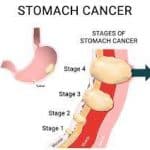Stomach cancer or gastric cancer usually begins in the stomach’s inner lining. If untreated, it can grow deeper into the layers of the stomach wall. It can also spread to nearby organs, including the liver and pancreas.
Signs and symptoms of stomach (gastric) cancer
- Appetite loss (Anorexia) .
- Dysphagia (Painful swallowing)
- Fatigue (Tiredness)
- Nausea
- Vomiting (Emesis)
- Abnormal weight loss
- Heartburn
- Indigestion (Dyspepsia)
- Black stool
- Flatulence (Bloating)
- Abdominal Pain (Bellyache)
Diagnostic tests for stomach (gastric) cancer
- Upper endoscopy diagnoses stomach cancer. A tiny camera attached to a thin tube is inserted into the stomach through the mouth. It helps to remove a tissue sample for biopsy.
- Endoscopic ultrasound can help stage cancer. The endoscope has an ultrasound probe on its tip to take pictures of the stomach. It can detect the cancer spread from the stomach lining to the stomach wall.
- Laparoscopy allows for to assessment of cancer spread when less invasive methods fail to provide correct information. A doctor inserts a tiny camera into minor cuts in the abdomen to see the organs directly.
- Radiologic tests, including a CT scan, barium swallow, PET scan, and MRI, can help detect tumors and cancer throughout your body.
- Blood tests provide information about organ function and cancer burden.
How to determine the severity of stomach (gastric) cancer?
- Stage 0
Presence of abnormal or cancerous cells only on the surface of the stomach lining.
- Stage 1
The tumor extends into deeper layers of the stomach. Cancer may have spread to surrounding lymph nodes.

- Stage 2
The cancer spreads to the lymph nodes but not to other body parts.
- Stage 3
The tumor grows into nearby organs. Finally, cancer spreads to the lymph nodes.
- Stage 4
Cancer spreads to distant body parts such as the lungs, brain, or liver.
Treatment options for stomach (gastric) cancer
Surgery
Depending on cancer spread, your provider may recommend surgery to remove pre-cancerous cells, a tumor, or partial or all of your stomach.
- Upper endoscopy is beneficial for the early stages when the cancer is limited to the uppermost layers. It involves endoscopic submucosal dissection or endoscopic mucosal resection.
- Gastrectomy (removal of a portion or all of the stomach) is useful when the tumor spreads beyond the uppermost layers.
- Chemotherapy drugs kill cancer cells, making the tumor easier to remove before surgery. It also kills the any remaining cancer cells after surgery. Chemo is more effective in combination with radiation or targeted drug therapy.
- Radiation Therapy involves energy beams to destroy cancer cells. Radiation is helpful alongside chemo before and after surgery. It can also be used to relieve symptoms like pain in more advanced gastric cancer.
- Targeted therapy drugs detect and destroy specific cancer cells. It’s more effective alongside chemotherapy to treat cancer recurrence or advanced cancer.
- Immunotherapy strengthens the immune system to identify and destroy cancer cells. It helps treat cancer recurrence or advanced cancer.
What are the alternative treatment options?
The viable alternative options may or may not be standard treatment. It includes vitamins, herbs, and diet. Some of these may be useful. A few may be harmful. Discuss other suitable treatment alternatives with the doctor.
What to expect after treatment?
You may have a fear of cancer recurrence. Visit your doctor periodically after the treatment ends. For the first year, the follow-up visits may be every three months. After the first year, follow-up visits might be every six months and then once a year after five years.
Do not skip follow-up visits. Your doctors will ask you about new symptoms. A physical examination and diagnostic tests may help to check recurrence.
Dealing with cancer is challenging. So, it would help if you thought about improving your health. Ankr is a popular cancer platform that helps patients to prevent side effects and live healthier during cancer treatments. Get your free Ankr account now!
Last updated: 07/15/22
